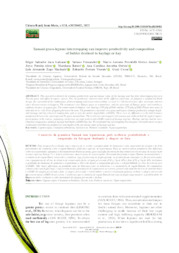Tamani grass-legume intercropping can improve productivity and composition of fodder destined to haylage or hay.
Tamani grass-legume intercropping can improve productivity and composition of fodder destined to haylage or hay.
Autoria: RETORE, M.; MACHADO, L. A. Z.; CECCON, G.
Resumo: This research evaluated the biomass productivity and nutritional value of the haylage and hay from intercropping between Tamani grass and different legume species. For the productive characteristics of the different intercrops, we adopted a randomized block design, for evaluation of the combination of intercropping and conservation technic we used 5 x 2 factorial scheme (five intercrops and two types of conservation techniques). The treatments were Tamani grass as monoculture, and the intercrops of Tamani grass with crotalaria, soybean, cowpea, or pigeon pea. The conservation techniques were haylage (520 g/kg of DM) and hay (870 g/kg of DM). Plants were sown in alternate rows, with 45 cm of spacing between the rows. The parameters evaluated were grass and legume biomass production, canopy height, and haylage and hay chemical composition, and in vitro dry matter digestibility (ivDMD). There were no differences in the total biomass production between the intercrops and TA grass monoculture. The treatments intercropped with cowpea and soybean had the highest legume participation in the mixture, promoting an increase in crude protein and ivDMD content of haylage and hay. Haylage and hay had the same chemical composition, although haylage had higher ivDMD than hay. We concluded that intercropping Tamani grass with soybeans or cowpea maintained total biomass productivity and improved the nutritional value of haylage and hay
Ano de publicação: 2022
Tipo de publicação: Artigo de periódico
Unidade: Embrapa Agropecuária Oeste
Observações
1 - Por padrão são exibidas publicações dos últimos 20 anos. Para encontrar publicações mais antigas, configure o filtro ano de publicação, colocando o ano a partir do qual você deseja encontrar publicações. O filtro está na coluna da esquerda na busca acima.
2 - Para ler algumas publicações da Embrapa (apenas as que estão em formato ePub), é necessário ter, no celular ou computador, um desses softwares gratuitos. Sistemas Android: Google Play Livros; IOS: iBooks; Windows e Linux: software Calibre.
Acesse outras publicações
Acesse a Base de Dados da Pesquisa Agropecuária (BDPA) para consultar o acervo completo das bibliotecas da Embrapa.

